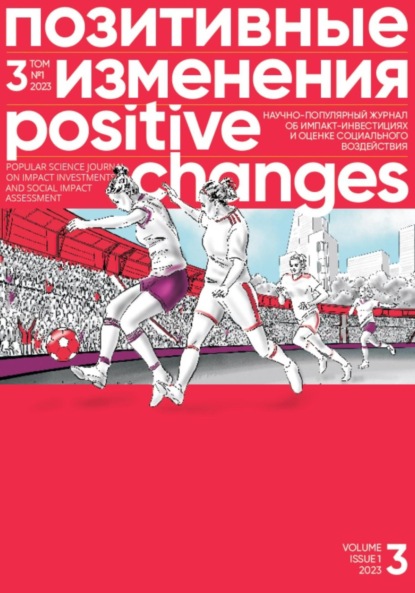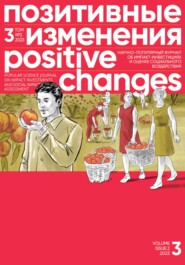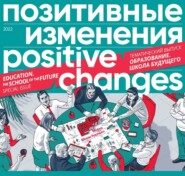По всем вопросам обращайтесь на: info@litportal.ru
(©) 2003-2024.
✖
Позитивные изменения, Том 3 №1, 2023. Positive changes. Volume 3, Issue 1 (2023)
Настройки чтения
Размер шрифта
Высота строк
Поля
• Девочки получают удовлетворение и удовольствие от игры;
• Девочки понимают, что идея о том, что только мальчики способны играть в футбол, была ложной;
• Избавление от одного из гендерных стереотипов помогает девочками убедиться в возможности гендерного равенства.
В ходе оценки экспертам нужно будет оценить вероятность того, что достижение очередного результата в этой цепочке обеспечит реализацию следующего шага. Например, если девочки пройдут полный курс тренировок в академии (15 часов), какова вероятность того, что они овладеют базовыми навыками игры?
ЗАКЛЮЧЕНИЕ
Мировой опыт показывает, что проекты, реализуемые в сфере физической культуры и массового спорта, могут создавать как значимые позитивные социальные изменения, так и негативные эффекты. Важным результатом проведенного исследования стала систематизация данных эффектов, что поможет организациям, реализующим и поддерживающим проекты в сфере социального спорта, в их идентификации и оценке. Использование различных видов оценки позволяет выявлять и измерять создаваемые изменения на всех стадиях реализации проекта, что, в свою очередь, помогает лучше управлять процессом изменений. Кроме того, оценка важна для обоснования объемов финансирования и выбора направлений стратегического развития, что особенно актуально в современных условиях, когда все социальные инициативы уже не могут рассчитывать на прежний уровень поддержки из бюджетных и внебюджетных источников.
The Power of Sport. Evaluation of Projects in the Field of Physical Culture and Grassroots Sport
In 2020, the Vladimir Potanin Foundation launched the “Power of Sport,” a charitable initiative aimed at uncovering the potential of sports as a social institution. In preparing the launch of the program, the Foundation experts had to study the experience of evaluating project effectiveness, in both an international and Russian context – as well as develop approaches to the selection of promising development areas, including identification and evaluation of effects. To address these problems, the Financial University under the Government of the Russian Federation conducted a study in 2022 aimed at identifying the effects achieved through the implementation of social sports projects and summarizing the approaches used to evaluate them.
Ilya Solntsev
Doctor of Economics, Head of the Department of Management and Marketing in Sports, Financial University under the Government of the Russian Federation
Natalia Kosheleva
Consultant on monitoring and evaluation of social programs and projects, president of the Association of Specialists in Program and Policy Evaluation (ASPPE)
SOCIAL EFFECTS OF SPORTS PROJECTS
Projects implemented in the sphere of physical culture and grassroots sport address a wide range of problems that go beyond the category of “sports”: a number of changes occur in the economy, education and professional sphere, adaptation and socialization, and demography. Sports projects also affect people’s well-being, by changing crime and disease rates. Such a broad range of impacts resulted in the creation of the “Sport for Development” concept, which emerged in the middle of the 20th century. The first scholar to set up its theoretical basis was the American psychologist Gordon Allport (1954), who suggested that contact between different groups of people with different characteristics, including gender, ethnicity and race, was the most effective means of fighting racism, prejudice, and discrimination.
Based on this theoretical framework, Alexis Lyras (2011) suggested that sport initiatives could promote personal development and social change through the use of non-traditional management methods and by combining sports with cultural and educational activities. A number of analytical portals concept are dedicated to the “Sports for Development” concept, for example: Sport for Development[70 - Sport for Development. (2023). Retrieved from: https://www.sport-for-development.com/home. (accessed 30.01.2023).], and Sport and Development[71 - Sportanddev.org. (2023). Retrieved from: https://www.sportanddev.org/en. (accessed 30.01.2023).], along with multiple studies by global organizations such as UNICEF[72 - UNICEF. (2019). Getting into the Game. Understanding the evidence for child-focused sport for development. Retrieved from: https://www.unicef-irc.org/getting-into-the-game. (accessed 30.01.2023).] and the UN[73 - United Nations. (2003). Sport for development and peace: Towards achieving the millennium development goals. Report from the United Nations Inter-Agency Task. Force on Sport for Development and Peace. Retrieved from: https://www.sportanddev.org/sites/default/files/downloads/16_sport_for_dev_towards_millenium_goals.pdf. (accessed 30.01.2023). https://doi.org/10.18356/b7ee7a39-en.]. The impact of sports on the society as a whole can be summarized via the UN Sustainable Development Goals[74 - Sportanddev.org. (2019). Measuring the contribution of sport, physical education and physical activity to the Sustainable Development Goals. Retrieved from: https://www. sportanddev.org/en/toolkit/sport-and-development-policy/policy-monitoring-and-evaluation. (accessed 30.01.2023).].
The effects generated by sports projects can be classified into positive and negative, and by the direction of the impact – in the context of the social sphere, health and economy (Figure 1).
Figure 1. Effects generated by sports projects
Source: Vladimir Potanin Foundation. (2022). Social Sports: measuring the effectiveness. Methods for evaluating the effectiveness of social projects in sports.
The positive social and health effects of sports are well summarized and, more importantly, quantified in the work by Larissa Davies et al. (2019):
1. Exercise in sports leads to a 1 % increase in education (11–18 years).
2. Graduates who had engaged in University sports earn 18 percent more a year on average than those who had not.
3. Exercise leads to a 1 % decrease in criminal incidents among men aged 10–24.
4. Participation in sports is associated with higher subjective well-being.
5. Volunteering in sports is associated with improved individual subjective well-being and greater satisfaction with life. The time spent by volunteers is equivalent in value to an average hourly wage.
6. Athletes are 14.1 % more likely to report good health than non-athletes. Sports and moderate-intensity physical exercise in adults, among other things, reduce the risk of:
• coronary heart disease and stroke in active men and women by 30 % on average (between 11 and 52 %);
• breast cancer in active women by 20 % (between 10 and 30 %);
• colorectal cancer by 24 %;
• type 2 diabetes by 10 %;
• dementia by 30 % (between 21 and 52 %).
Researchers from New Zealand reached similar conclusions[75 - Sport New Zealand. (2023). The value of sport. Retrieved from: https://sportnz.org.nz/resources/the-value-of-sport/. (accessed 30.01.2023).]:
• 84 % of respondents agreed that sports help develop important life skills such as teamwork and cooperation;
• for New Zealanders who participate in sports, the level of well-being increases 59 %;
• sports help develop social skills and make new friends (including for migrants);
• high-performance sports help instill a sense of pride in the country and contribute to national identity;
• physical activity and sports reduce the risk of cardiovascular diseases (7.9 %), type 2 diabetes (9.8 %), dementia (7.7 %), breast cancer (13.1 %), and stomach cancer (14.1 %);
• sports and recreation provide 53,000 jobs and contribute $4.9 billion to GDP annually.
A broad range of impacts resulted in the creation of the “Sport for Development” concept. It was first described by the American psychologist Gordon Allport.
In terms of the impact of sports on the economy, Europe offers noteworthy experience[76 - European Commission. (2012). Study on the Contribution of Sport to Economic Growth and Employment in the EU. Retrieved from: https://ec.europa.eu/assets/eac/sport/library/studies/study-contribution-spors-economic-growth-final-rpt.pdf. (accessed 30.01.2023).]. For example, in 2012, the gross domestic product (GDP) associated with sports was EUR 279.7 billion, or 2.12 % of the total GDP in the EU. In addition, 5.67 million workers can be attributed to the sports industry, which is 2.72 % of the total number. In other words, one in 47 Euros and one in 37 employees in the EU are directly related to sports. These figures were derived from costoutput tables for sports based on national Sport Satellite Accounts.
Indirect multipliers were also used in the calculations, taking into account that each business needs the raw materials from other industries to make its products and/or provide services. Multipliers show how much output from other sectors is needed to produce a certain commodity. For example, producing a sports car requires seats, which in turn requires textiles, etc. The magnitude of multipliers depends primarily on the structure of economic ties between the original sector and the other industries. The more sectors are interconnected, the higher the multipliers. Applying multipliers to direct effects generates indirect effects. For example, if a soccer stadium costs 30 million euros to build (direct effect), and the construction sector reports a multiplier of 1.8, the indirect effect would be (1.8–1.0) x 30, that is, 24 million euros. Note that the supply chain involves national enterprises as well as foreign countries, but the primary effects for the country depend only on the import-adjusted costs.
In terms of economic effects, it is also necessary to consider the athletes’ costs to purchase the equipment, pay for attending the sports sections, travel to competitions (payment for tickets, food, accommodation). In addition, a significant effect can be achieved by the growth of commercial indicators (sponsorship revenues) for those projects that attract a significant audience.
Territorial development[77 - European Commission. (2020). Contribution of sport to regional development through Cohesion Policy 2021–2027. SHARE initiative research paper. Retrieved from: https://keanet.eu/wp-content/uploads/SHARE-The-contribution-of-sport-to-regional-development-through-CP-2021–2027-FINAL.pdf. (accessed 30.01.2023).] is another important effect of many sports projects:
• stimulation of business activity;
• creation of local jobs (including indirectly through construction projects);
• increasing the appeal of the territories and improving their image;
• contributing to the innovation and development of information and communication technologies (ICT) with sporting content;
• greater economic mobility of the population.
In the context of territorial development, it is worth mentioning a whole block of studies devoted to the assessment of economic effects produced by major sport competitions: Gureeva & Solntsev (2014), Baade & Matheson (2004), de Nooij et al. (2013), Preuss (2007), Maennig & Zimbalist (2012).
Numerous studies have documented negative effects of sports as well. For example, it is well known that physical activity can be a stimulus towards alcohol consumption (Lisha et al., 2011). Many studies point to higher rates of alcohol use among athletes compared to non-athlete peers (Leichliter et al., 1998). A common explanation is that athletes tend to celebrate their victories (or experience failure), and teaming encourages this behavior (Leasure et al., 2015).
Sports can also have a negative impact on the environment, including by increasing emissions of harmful substances. For example, Wicker (2019) surveyed adults in Germany and asked them to report their sports-related travel, including in the context of regular (weekly) activities, sports competitions/tournaments, and training camps. The annual carbon footprint was estimated using information on travel distances and vehicles used. The results showed an average annual carbon footprint of 844 kg of emissions (carbon dioxide equivalent), with individual sports providing more emissions than team sports.














